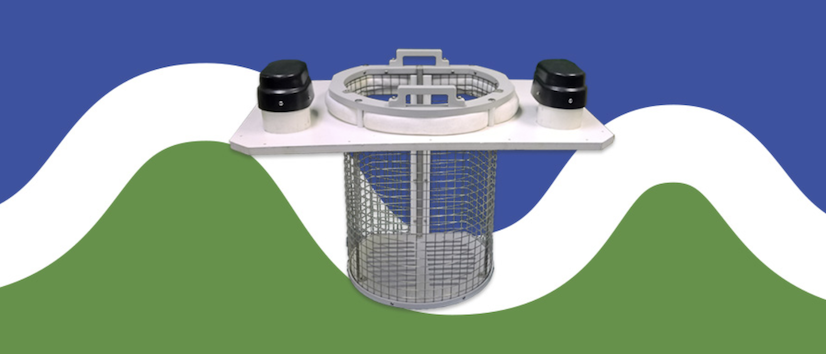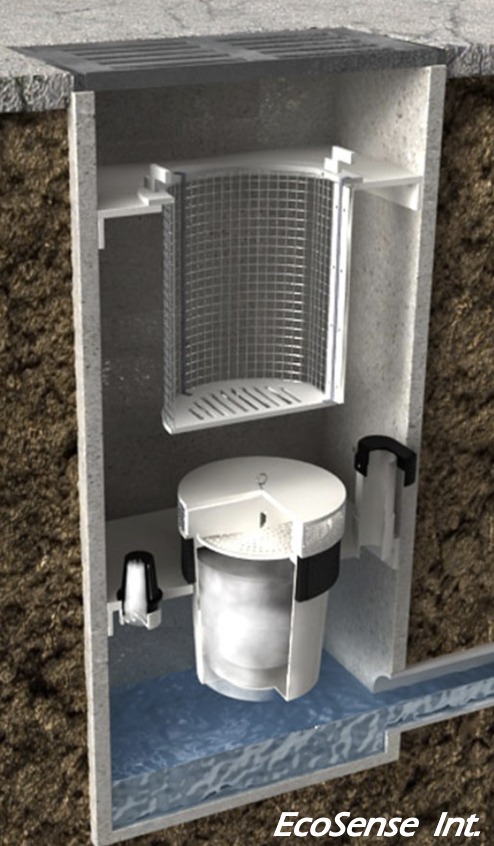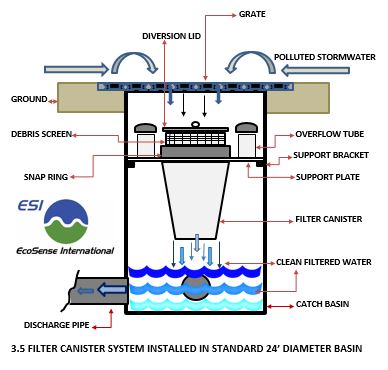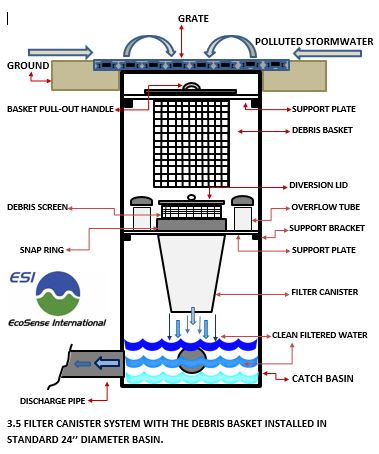
 Stormwater Filters & Debris Systems
Stormwater Filters & Debris Systems Simple Solutions to Water Pollution

Stormwater runoff is the largest single contributor to water pollution. Sheet flow of rainwater or snowmelt which passes over land, streets, roofs and parking lots becomes laden with many contaminants. Once it passes into the drainage network, whether it’s a series of pipes, culverts or a canal it’s called stormwater and will usually flow to the nearest surface water like a rivers, lakes, estuaries or the ocean, called receiving waters.
Some of the contaminants that stormwater transports are: phosphorus, nitrogen, heavy metals, petroleum products, yard wastes, feces, PCB’s all of which can severely impair our treasured natural resources. Pollution from diffuse sources like this is termed Nonpoint Source Pollution.
Perhaps the most effective approach for reducing pollution from runoff is to stop it at its source or the point it enters the drainage system. EcoSense International’s Catch Basin Insert Filtration Systems are designed with this in mind.
The US Environmental Protection Agency (EPA) estimates that half of all pollutants in waterways of the US comes from urban runoff.
Urban Centers negatively impact water quality; contributing nutrient, bacteria, heavy metals and hydrocarbons to receiving waters. Construction of roads, residential and commercial properties increases soil erosion and reduces pervious surface-resulting in less infiltration and more runoff.
Let EcoSense be part of your BMP and TDML plans
EcoSense International, Inc.™ Stormwater Filtration Systems are internationally tested and utilized structural devices, designed to remove suspended and emulsified oils and grease, heavy metals, sediments and debris from sheet flow entering the stormwater conduit through a catch basin or other inlet structure. They are sized to fit virtually any storm drain structure and are easily modified on site for unusual circumstances. The unit consists of a support structure, filter(s), debris screen and overflow bypass tubes. The bypass system has been recently improved to effectively detain floating pollutants during design overflow. When the over-flow conditions abate, the filters are able to trap the detained pollutants.
The EcoSense Stormwater Filtration System removes high percentages of petroleum based hydrocarbons (PBH), TSS (Total suspended solids) and Sediment.
Media additives are available that will remove dissolved heavy metals and ortho-phosphates, or enteric, pathogenic and fecal bacteria.
System Design
 From spill-over wash-down areas, heavy equipment break-down, non-standard basins, and many other instances, EcoSense® has the ability to bring innovative ideas to reality and customize a solution to address your specific needs. Based on your input, we choose the best media load for your application to target specific contaminants.
From spill-over wash-down areas, heavy equipment break-down, non-standard basins, and many other instances, EcoSense® has the ability to bring innovative ideas to reality and customize a solution to address your specific needs. Based on your input, we choose the best media load for your application to target specific contaminants.
The systems are typically installed in existing or new catch basins and are designed to handle the first flush volume for the basin’s given drainage. The “Clean Pass” over-flow systems are built to handle a flow nearly equal to the basin’s discharge capacity.
Filter canisters can be loaded with media targeting specific pollutants including dissolved heavy metals. Media specific for higher flow capacities is also available.
Canisters are disposable but are generally recycled and reused. The media may be discarded to “lined” landfills or burned in garbage to energy plants or cement kilns. The largest canister will handle 37 GPM and trap 20 pounds of oil and grease and other contaminants. A 3-filter system, including clean pass overflows has a 1.0 cfs (cubic feet per second) capacity.
Retrofitted designs are customized to meet current stormwater remediation requirements.
Maintenance
The filter(s) will usually require replacement once a year. Depending on sediment loads, the system should be cleaned of debris and sediment biannually. The cleaning may be accomplished with a light duty vacuum and usually takes only 15 or 20 minutes. To gain access to the basin’s sump simply pull the filter out. Catch basin sump cleaning frequency, which requires heavy vector equipment, will be greatly reduced with the system installed.
Debris Baskets
The EcoSense Stormwater Debris Baskets (patent pending) significantly reduce nutrient load. They are an important part of your treatment train; helping to meet TMDL requirements. They are designed to easily retrofit most of any existing drainage structures or can be customized to complement a new construction. They capture litter, foliage and other debris that have been diverted from the stormwater effluent, improving both the health and appearance of the waterways. Selecting an appropriate mesh size can control the size of the materials trapped in the system. If desired, very fine mesh can be applied to the lower section of the basket to remove sand or finer sediments. Hydrocarbon absorbent booms may be installed on the basket’s rim to “skim” oils and grease. Over-flow tubes may be installed where required.
Debris collection insert systems have been proven effective with nutrient removal and are expected to reduce nutrient load between 40-90% depending on clean out frequency.
System Design
The system is constructed from stainless steel and high strength plastics that are resilient to ultraviolet rays. A support deck is installed across the catch basin, which the basket fits into. The deck may be supported by cleats bolted to the basin walls or hung by straps from the grate landing and may contain optional high flow “clean pass” overflow tubes. Hydrocarbon absorbent booms may be added to the system as desired.
Mesh size is optional; typically 0.5” or 1.0”. Finer mesh may be added to trap additional sediments. It is recommended that a grate be used for curb inlet installations to prevent large debris and trash items from entering the throat of the inlet. This will minimize cleanout frequencies.
EcoSense grates are inexpensive and utilize a unique installation method that takes only about 20 minutes. They are custom designed to target certain sized debris items.
Maintenance
Cleanout of the baskets may be accomplished using light duty vacuum equipment or they can be emptied by hand. Time required for cleanout is between 5 and 10 minutes. The baskets should be inspected regularly over the first year to determine the approximate frequency required. Areas with large amounts of leaf debris may require cleanouts monthly. Highly urbanized areas usually require maintenance quarterly. Regular maintenance will greatly increase nutrient removal efficiency.

EcoSense™ filters have been approved by the EPA as a Best Management Practice for stormwater management and can help satisfy National Pollutant Discharge Elimination System (NPDES) regulations. Any storm sewer that discharges to a local watercourse or stormwater pond is a good candidate for this filtration system. “Storm basin inlet filtration animation”.


